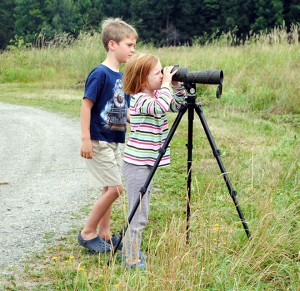

by Richard Creaser
copyright the Chronicle 8-15-2012
DERBY — Michael Dunn’s generous donation of 457 acres on Eagle Point in Derby was celebrated Friday morning. Mr. Dunn, who died in 2007, donated the land to the federal government as a stipulation in his will. The town of Derby appraised the Eagle Point property at $2,092,600.
As generous a bequest as it was, its value to the natural community exceeds the land’s price tag. With a unique mixture of wetlands, agricultural land, pasture and forest, the Eagle Point property provides critical habitat to dozens of rare and endangered plants and animals. Placing the land in the public trust also ensures that future generations of Vermonters and visitors will retain lakeshore access as well as the ability to enjoy the wildlife resident therein.
“What we’ve always loved about Eagle Point is how undeveloped it is,” neighbor Gail Rose said. “The fact that Mr. Dunn sought to have it preserved ensures that the quality of the experience will remain.”
Ms. Rose and her family bought one of the lakeside cottages that formed part of the original property. As an owner of the northernmost of the cottages along the east side of Lake Memphremagog, Ms. Rose expressed her pleasure at having the U.S. Fish and Wildlife Service as her new neighbor.
The Eagle Point property is the newest addition to the Missisquoi National Wildlife Refuge based in Swanton. Although overseen by U.S. Fish and Wildlife, the property will be directly managed by the Vermont Department of Fish and Wildlife through a unique partnership.
That partnership was created owing in part to the unusual nature of Mr. Dunn’s bequest. He had stipulated a deadline of September 1, 2010, for transfer of ownership to the federal government. If the federal government failed to take ownership by that deadline, the property would be sold, with the proceeds going to support the Museum of Modern Art in New York City.
The Vermont Land Trust entered the picture working alongside the estate’s trustees, Community Financial Services Group. Normally, the Land Trust purchases a development easement which protects the property, Vermont Land Trust President Gil Livingston said. Given that the land was being transferred to the federal government, however, this was not possible.
“Our role in this was as a facilitator,” Mr. Livingston said. “We put together the partners and got the dialogue going. This was a challenging situation but the ultimate outcome was so great it was a challenge we gladly accepted.”
As the agents for Mr. Dunn’s estate, Community Financial found itself in a position trying to weigh Mr. Dunn’s wishes against bureaucratic process. For example, though federal wildlife refuges do not typically permit overnight camping, Mr. Dunn insisted that primitive campsites be provided for the enjoyment of canoeists on the Northern Forests Canoe Trail.
“This was one of the most challenging estates we have ever handled,” said Janet Cartee of Community Financial Services Group. “But I couldn’t help but be excited about being part of the process.”
Under ordinary circumstances, federal land acquisition is a long and slow process. Because of the rigid timeline, the government had to move far faster than it normally would, Sue McMahon said. Ms. McMahon is the deputy chief for the U.S. Fish and Wildlife Service’s Northeast Region.
“Getting the job done in a year was like a light year in the federal bureaucracy,” Tom Berry of Senator Patrick Leahy’s office acknowledged.
Wide-ranging support from Vermont’s Congressional delegation, the Vermont Agency of Natural Resources, and local, state and town representatives enabled the project to pass through an expedited process, Mr. Berry said. The end result was the creation of a joint conservation effort that protects a unique habitat, Vermont Fish and Wildlife Commissioner Pat Berry said.
Though the refuge is still a work in progress, Missisquoi National Wildlife Refuge Manager Ken Sturm extended his thanks to the Student Conservation Association (SCA). The SCA helped to develop the trails and amenities that will make the refuge a visitor attraction.
Students in the SCA program are young people with an interest in conservation, Gary King, spokesman for the SCA said. Their involvement in this project highlights the fact that America’s young people do take pride and ownership of the nation’s precious natural resources, Mr. King said.
Michael Hickcox, a longtime friend and neighbor of Mr. Dunn, spoke warmly of the efforts taken to fulfill Mr. Dunn’s final wishes. His belief that the land should be preserved was widely known among his friends and associates, Mr. Hickcox said.
“It’s hard to think about Eagle Point without thinking about Mike,” he said. “This is exactly what Mike had in mind for it. When the farmhouse was torn down it was very poignant but very beautiful at the same time.”
That powerful connection was what made Friday’s ceremony so appropriate. In honoring Mr. Dunn’s generous gift, the state and the nation acknowledge Mr. Dunn’s enduring love of the land, Mr. Livingston said. Though Mr. Dunn was a Canadian national, he expressed his appreciation of the United States by making this unique gift. Mr. Dunn also bequeathed his property on the Canadian side of the border to the province of Quebec, Mr. Livingston added.
“He deeply appreciated this place and honored Americans by making this particular legacy,” Mr. Livingston said. “It’s a spectacular outcome.”
At the conclusion of Friday’s dedication ceremony, Mr. Sturm unveiled a bronze plaque that will be placed on the property acknowledging Mr. Dunn’s generous contribution. That plaque will evermore honor a man who loved the land so deeply that he ensured it would be preserved for the enjoyment of future generations.
contact Richard Creaser at [email protected]







